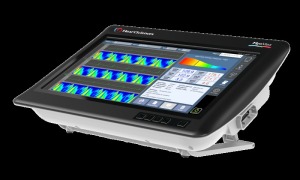New advanced ECG tool for cardiac disease now available in Europe
by
John R. Fischer, Senior Reporter | August 21, 2017

MyoVista high sensitivity
electrocardiograph Testing Device
European cardiologists may soon be able to detect the presence of heart disease more effectively in patients, thanks to a new advanced ECG tool.
HeartSciences’ MyoVista high-sensitivity electrocardiograph (hsECG) Testing Device is now available for sale and distribution in markets across the European Union, following CE approval.
“Our device performs all of the functions that normal resting ECG does that you would expect in a higher performance 12-lead, resting ECG that hospitals would use, for instance,” Mark Hilz, president and CEO of HeartSciences, said. “Our device performs all those functions, plus it provides additional informatics that will provide additional information related to cardiac dysfunction.”
MyoVista hsECG uses continuous wavelet transform, an advanced form of signal processing, to transform ECG signals into energy distribution during the cardiac cycle. Traditional ECG only examines analog waveforms of signals.
The device then analyzes the signals to measure the energy of the heart during each heartbeat, especially during its resting stage, with HeartSciences asserting that the use of continuous wavelet transform increases the sensitivity of detection in the device for the presence of cardiac disease.
“Once we’ve transformed the wave form, we look at the T-form, the resting stage, which is when sub-clinical heart disease typically manifests itself,” Hilz said. “So, if you have structural disease such as valve disease or hypotrophy or cardiomyopathy, or you have coronary arterial disease, it’s typically going to be seen in the resting phase or the diastolic phase, which is when the T-wave occurs.”
A trial conducted for the presence of left ventricular diastolic dysfunction in 200 patients found that the devices showed 88% sensitivity and 87% specificity in detecting cardiac dysfunction in the diastolic phase of the cardiac cycle.
It uses the same 12-lead, at-rest testing protocol as traditional ECG, making it easier for physicians and clinical staff to quickly assimilate it for use. But the device can also act as one single test, is less costly than traditional ECG tools, may be used on asymptomatic patients, and could be used to detect cardiac disease in patients at an earlier stage.
“ECG technology has been around for a hundred plus years. For a hundred plus years, they’ve been looking at that normal cardiac monitor wave form, and we are the first ones to use signal processing to transform the waveform … we’ve transformed the waveform and found very useful data on whether heart disease is present, whether there is true dysfunction related to structural or coronary arterial disease.”
HeartSciences is currently working to obtain approval for MyoVista hsECG in Australia, Canada, Latin America, the Middle East and Asia-Pacific. It is seeking to submit the device for FDA approval in 2018.
|
|
|
You Must Be Logged In To Post A Comment
|
